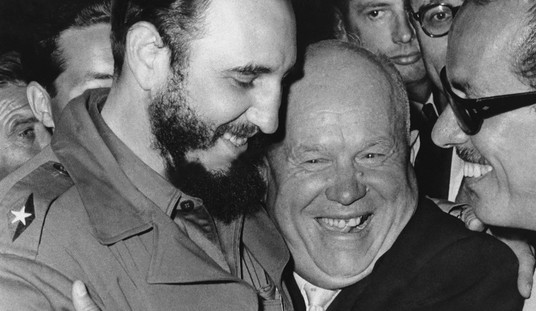At first, attacks on monuments memorializing Abraham Lincoln looked like collateral damage in the current nihilistic meltdown taking place in American cities. However, the sixteenth president, considered to be either the greatest or second-greatest of American leaders, has become a prime target of radicals determined to cleanse the landscape of any history at all. The Great Emancipator no longer has the woke credentials to survive, apparently.
Not in Madison, Wisconsin, anyway:
Students at the University of Wisconsin-Madison are demanding that the university remove and replace a statue of Abraham Lincoln.
“Many UW-Madison students wait to take their picture on the lap of the Abe Lincoln statue atop Bascom Hill when they graduate,” a Change.org petition states. “However, few know how this statue got to the top of the hill, and who put it there.”
The petition, which has more than 300 signatures, goes on to take issue not necessarily with the statue depicting Lincoln, who the author says had a “questionable” history when it came to race relations, despite the fact that Lincoln, as president, issued the Emancipation Proclamation aimed at freeing slaves.
Instead, the author takes issue with the people who paid to construct the statue, one of whom “was well-known for holding ultra-racist beliefs,” and the other who was “a known member of the KKK.” The petition states that the Lincoln statute “was merely a git of political capital” and unimportant to “the creation and continuation of education” at the university.
UW-Madison should not put up statutes “as a reminder of racist legacies that contributed to this campus,” the petition argues.
Ahem. It seems a bit far-fetched that a member of the KKK paid money to create statue of Lincoln. Not to belabor the point too much, but Lincoln was a specific target of hate for that domestic-terror organization for his role in defeating the South as well as emancipating all of its slaves. The KKK was much more interested in building monuments to its “Lost Cause” heroes than to the man who crushed them. And even if the money came from supposed “racists,” the monument itself signifies the fight to make all people free and equal — which is its obvious and apparent point.
You’d think that point would resonate most in Washington DC, but … not so much, not even for a monument that freed slaves made to honor Lincoln. Protesters have threatened to pull it down, calling its imagery “racist” and demanding its destruction. Those demands continued last night, with an announcement of violent revolution as the aim:
The effort to remove statues continues in the District Thursday night, with protesters planning to gather again at Lincoln Park with a previously stated intent to tear down the Emancipation Memorial.
“To achieve true justice, we are not working with the police, nor will we seek any relationship with them,” the Freedom Neighborhood, who organized the June 23 effort, wrote in an Instagram post. “In order to create change, we will do so by any means necessary. If you want a revolution, it won’t happen by being peaceful.”
The memorial, erected in 1876, depicts Abraham Lincoln holding the Emancipation Proclamation over a kneeling newly freed African American man who is still shackled. Some argue that while the Emancipation Proclamation changed the course of history, the statue oversimplifies the violent history that came before it, instead of memorializing Lincoln and not the many enslaved.
Beyond the depiction of a freedman at the feet of the former president, critics also say formerly enslaved Americans did not have any say in how it was built and fails to note the degree which enslaved African Americans pushed for their own emancipation.
This pretty clearly shows that the goal here isn’t anti-racism as much as it is violent revolution and utter nihilism. Lincoln’s just an excuse, or perhaps even worse for them, a symbol that America can improve and change to embrace more equality. They need to erase Lincoln in order to sell nihilism and despair. Oddly enough, that puts them in common ground with the KKK in this narrow case.
How serious is this threat? Serious enough that Frederick Douglass biographer David Blight appealed to the mob not to take down the Freedmen’s Memorial. Writing in the Washington Post yesterday afternoon, Blight conceded that the imagery may seem racist, but the meaning is anything but:
Do not tear down this monument. I fully understand that protests are not forums for complexity; current demonstrations are the results of justifiable passion and outrage. It is reasonable to clear our landscape of public commemoration of the failed, four-year slaveholders’ rebellion to sustain white supremacy known as the Confederacy, even if it doesn’t erase our history. But the Freedmen’s Memorial is another matter. For those contemplating the elimination of this monument, including D.C.’s delegate to Congress, Eleanor Holmes Norton (D), please consider the people who created it and what it meant for their lives in a century not our own. We ought not try to purify their past and present for our needs.
A huge parade involving nearly every black organization in the city preceded the dedication of the monument on April 14, 1876. The procession included cornet bands, marching drum corps, youth clubs in colorful uniforms and fraternal orders. Horse-drawn carriages transported master of ceremonies and Howard University law school dean, John Mercer Langston, and the orator of the day, Frederick Douglass, a resident of that neighborhood. Representatives of the entire U.S. government sat in the front rows at the ceremony; the occasion had been declared a federal holiday. President Ulysses S. Grant, members of his Cabinet, members of the House and Senate and justices of the Supreme Court all attended.
The $20,000 used to build the monument had been raised among black Americans, most of them former slaves. A former slave woman, Charlotte Scott, had donated the first $5. The sculptor, Thomas Ball, lived and worked in Italy. The model for the kneeling slave, Archer Alexander — a former slave — was photographed numerous times and had his pictures sent to Ball. Ball believed he depicted Alexander as an “agent in his own resistance,” an assumption of course roundly debated to this day.
A young black poet from D.C., Cordelia Ray, recited an original poem, “Lincoln.” Grant, who did not speak, pulled the cords and unveiled the statue. Douglass then took the podium and delivered one of the greatest speeches of his life.
No African American speaker had ever faced this kind of captive audience of the full government, and none would do so again until Barack Obama’s inauguration as president in 2009.
Blight had me at “do not tear down this monument.” Put simply, these monuments belong to the entire community, not the mobs present at any one time. DC mayor Muriel Bowser scolded the crowd, saying that a “reasonable conversation” about memorials should take place with everyone’s input, not violent solutions imposed on communities by mobs:
Mayor Muriel Bowser said Thursday the District must “have a reasonable conversation” when deciding how and when to take down statues and historical monuments as protests continue around D.C.
“I think what we need to do with statues is to have a reasonable conversation,” Bowser said during a press conference Thursday. “Not have a mob decide they want to pull it down, and certainly not destroy anything in the District and set anything on fire.”
The revolutionaries don’t want a “reasonable conversation.” They want to usurp the role of “the people” by claiming that mantle for themselves alone, and burn down everything else in their path. The nature of these protests have become apparent even to Bowser and others, and it’s not going to escape the notice of voters in November, either.
Addendum: Ken Masugi, a Johns Hopkins University lecturer, writes Power Line to scold Blight for his intellectual cowardice:
Distinguished Frederick Douglass biographer David Blight should be ashamed of himself. His op-ed “Yes, the Freedmen’s Memorial uses racist imagery. But don’t tear it down” (June 25) contradicts what he writes about the Memorial in the first pages of his fine biography. In his column, Blight asserts: “It was and is a racist image.”
In his biography, historian Blight provides one of the best defenses of the image of the rising (not kneeling!) freedman. Quoting the head of the Memorial Commission, Blight explains that the sculptor had altered his conception from a “’kneeling slave … represented as perfectly passive’ (freedom given), to an ‘emancipated slave [as] agent in his own deliverance’ (freedom seized), … the monument as an ‘ideal group … [was] converted into the literal truth of history.’” Blight imputes no racism. In fact, the sculptor changed his creation from what Blight now attributes to it!
Moreover, this spirit of freedom is evident to any unbiased observer, when one takes account of the totality of the imagery of the statue–from Lincoln’s Promethean, life-giving gesture (“the new birth of freedom” aimed at all Americans, not just the freedman) to the image of George Washington on the column. Here is a muscular man, who seconds before had been prostrate on his face, now rising up. He should of course have never been a slave!
There has been a pandemic of intellectual cowardice this season.









Join the conversation as a VIP Member